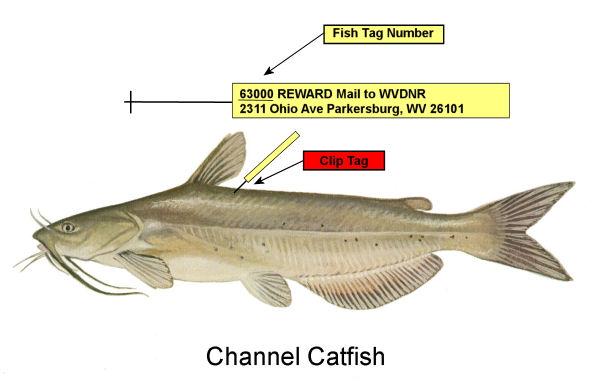FISH TAGGING PROGRAM
The DNR routinely conducts projects to gain a better understanding of our fishery resources and how anglers utilize this resource. One way we attempt to understand the extent that fish are caught by anglers is to tag recreationally important species and ask anglers to report the capture of these fish. Through this effort we also can gain an understanding of the amount these fish move and the success of our stocking programs. In the past, the DNR has conducted tagging studies on sauger, walleye, largemouth and smallmouth bass, hybrid striped bass, rainbow, brook and brown trout, as well as channel, flathead and blue catfish. All of these studies have provided the DNR with information that was useful for the wise management of these species. Information on these studies will be periodically provided in this section of the WVDNR website
In 2013, the DNR will be initiating tagging studies on catfish (channel, blue, and flathead) within the Ohio River, as well as channel catfish in several state park lakes. These fish will be tagged during May with either green (state park lakes) or yellow (Ohio River) tags that are uniquely numbered.
The purpose of these two studies are:
Ohio River Catfish Study
- Determine the rate of angler catch and harvest, and
- Determine the movement of these species within and between navigational pools.
State Park Catfish Study
- Determine the success of stocking catchable-size channel catfish in user-friendly lakes, and
- Determine the rate of catch and/or harvest of these stocked fish.
In addition, tagging studies are ongoing in the New River, South Branch, and Little Kanawha River on channel catfish, smallmouth bass, and flathead catfish. These studies are intended to provide information on fish movement and angler catch.
So How Can You Help
- The first step is to continue to fish these water bodies as you have in the past. This will provide the DNR a consistent platform for determining catch and harvest rates.
- The second step is to inspect all caught fish and look for the presence of tags. When tags have been in the water over a period of time, algae begins to attach resulting in the tag appearing brown or black.
- The last step is to report the capture of a tagged fish to the DNR. It is not required to return the tag, but if you want to either return the tag or keep it please clip the tag as close to the fish’s body as possible (see diagram)
- As part of this reporting step it is important to provide the DNR the following information:
- Tag Number: see example of a tag for location of tag number.
- Water Body of Capture:
- For all rivers please include location within the river.
- Date of Capture: month, day, and year of capture.
- If you released the fish or brought it home.
- Your name and address: Rewards are provided for ALL returned tags.
How Can You Report a Tagged Fish?
| |
By E-mail: |
dnrfishtags@wv.gov |
| |
By Telephone: |
304-420-4550 |
| |
BY Mail: |
WV Division of Natural Resources
Wildlife Resources Section
2311 Ohio Ave
Parkersburg, WV 26101 |
Fish Tags

|
.gif)
.gif)



